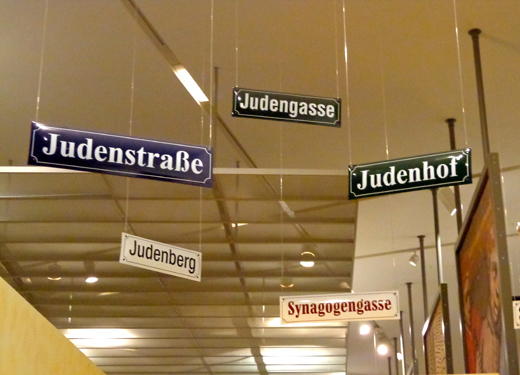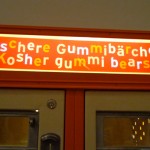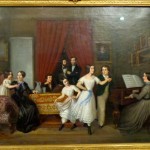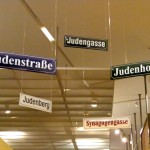
Have you ever been lost? Really lost, that is, in a space such as a maze or labyrinth? No matter whether you have or haven’t, the Jewish Museum in Berlin might be the perfect place to get lost in. Earlier this month, the students in Laura Scuriatti’s class on Museums, Collections, and Literature – a class which focuses on the development of the modern museum through history and on the organization and meaning of collections – had the chance to visit this unique museum. For me, a volunteer at the United States Holocaust Memorial Museum, this was also a unique comparative experience.
Opened in 2001, the museum presents an interesting mixture of history, culture, hardships and joys. The permanent exhibit of the museum is held in what is known as the Libeskind Building (named after its architect Daniel Libeskind) – a building filled with twists and turns, corridors that lead to nowhere, and empty spaces known simply as “voids.” The exhibit begins at the lower level and at a point of German-Jewish history that is most familiar to the world: the Holocaust. Upon entering, the visitors are presented with their first maze – a choice between three corridors, or axes: the Axis of the Holocaust, Axis of Immigration, and Axis of Continuity. The Axis of the Holocaust is the first corridor with a dead end, leading to what is known as the “voided void,” or the Holocaust Tower – a tall construction with bare concrete walls, unheated and lit only by the slightest sliver of practically nonexistent light. The second Axis, the Axis of Immigration, follows those Jewish citizens of Germany who were forced to flee. This axis leads to the Garden of Exile, which is built on an uneven slope and filled with a maze of its own composed of tall, solid white blocks. Finally, the Axis of Continuity leads up several flights of stairs to Level 1 (above the ground level), where the actual permanent exhibition begins.
Once out of the axes and into Level 1, the visitors find themselves in a room filled with light and color, and are taken back as far as the time of the Roman Empire, with the first Jewish settlements in Europe. From there, it is a maze (literally) of history and culture, covering everything from Jewish weddings, through the alphabet, to the long-winding history of segregation between Jews and Germans as early as the middle ages.
I came there as a visitor not only as part of my class, but also with an interest in comparing this museum to the one I have been volunteering in for over a year now and have grown to be quite familiar with – the U.S. Holocaust Memorial Museum in Washington. Indeed, I came to notice certain similarities, one of which, of course, was the space dedicated to the Holocaust, and the power of that space. The whole, four-level main exhibition of the museum in Washington is dedicated to the history of the Holocaust, from the rise of Nazism to power through the German federal election in March 1933, to the end of the Second World War, the victory of the Allied Forces over Germany and the liberation of the concentration camps. Although in the Jewish Museum the space dedicated to the Holocaust is much smaller, it can fill the visitor with an almost equal amount of dread and sadness, through the Holocaust Tower and the Garden of Exile. Which leads me to another similarity I noticed: namely, the power of the architecture, for, in both museums, their architecture plays a key role in the visitor’s experience – from the bricked walls, concentration camp style lamps and compacted spaces in USHMM, to the corridors leading to nowhere, and the voids in the Jewish Museum.
Yet, while there are similarities between them, the two museums have some rather fundamental differences. While both of them show aspects of history, the Holocaust Museum focuses on an event, which is not only part of Jewish history, but also part of human history as a whole. It is no coincidence that the word “memorial” appears in its name – in showing the horrors of this event, beginning with the rise of the Nazi party to power, and ending with WWII, the museum acts as a tool to remind the world of the dangers of propaganda and consequences of not acting when one witnesses a great evil – the loss of millions of lives – and thus becomes a symbol of the hope that such evil will never happen again.
The Jewish Museum in Berlin, on the other hand, focuses more on Jewish culture via Jewish history, and two aspects of it in particular: the ability of Jews to enjoy life and successfully make accomplishments in science and art in spite of societal barriers in Germany, and their ability to move forward. To highlight the first of these aspects, the museum exhibits numerous pieces of art from different periods, particularly paintings and photographs, and has small sections dedicated to Moses and Felix Mendelssohn, and to Albert Einstein – people who have left their mark on music and science. The second aspect, the ability to move forward, is indicated by Libeskind himself through the Axis of Continuity, which leads to the main exhibit after the space dedicated to the Holocaust.
The ultimate goal of the Jewish Museum is not only to teach, but also to force one to let go of any pre-conceived notions and focus on the place and on the culture of the Jewish-German population. A typical museum exhibit would go in a logical, straightforward progression; still, the exhibit of the Jewish Museum has been curated in such a fashion that it breaks with the traditional. It begins with the darkest part of Jewish European history, exhibited in the basement of the museum, and then takes a leap back two thousand years, to the Roman empire, and moves forward in a chronological order, but leads the visitor through mirror corridors or dead end corridors, somehow disrupting the continuous flow of history. In the end, the visitor is forced to let go of expectations and forget past museum visits, but instead focus on moving forward through the exhibit and on diving entirely in the present, through a wholly new experience.
And so, if you have the time to get lost while in Berlin, the Jewish Museum might be just the place – for it is a place worth getting lost into.




